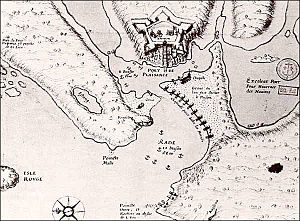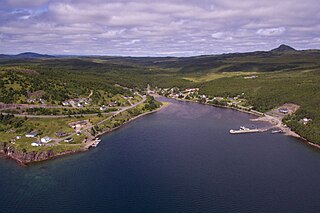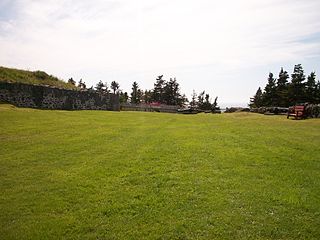| Fort Plaisance |
|---|
|
 Fort Plaisance in 1675 |
| Type | French fort |
|---|
|
| Built | 1662 |
|---|
Fort Plaisance was a French fort built in the 17th century on the island of Newfoundland at the time of the New France.
In 1662, the French established a strategic trading post in a well protected cove overlooking Placentia Bay that separates Avalon from the rest of the island of Newfoundland, located close to Grand Banks.
To protect this place, several forts were built around the cove, Fort Plaisance in 1662, Fort Royal in 1687, and Fort Saint Louis in 1690.
Fort Plaisance was built inside the harbor in order to protect the small port city of Plaisance from an attack enemy.
During its construction, the Fort Plaisance had earthen ramparts reinforced by wooden stakes. In the beginning it had four guns. Its armament was gradually increased and in 1667, the fort had 32 guns.
In 1713, the Treaty of Utrecht forced the French to abandon their settlements in Newfoundland. 'Plaisance' become 'Placentia'. The French inhabitants were moved to Île Royale which began the construction of Louisbourg.
Division No. 1, Subdivision A is an unorganized subdivision on the Avalon Peninsula in Newfoundland and Labrador, Canada. It is in Division No. 1, and lies between Trinity Bay and Placentia Bay.

Sunnyside is a town on the Avalon Peninsula in Newfoundland and Labrador, Canada. It is in Division 1 on Bull Arm.

The Avalon Peninsula is a large peninsula that makes up the southeast portion of the island of Newfoundland. It is 9,220.61 square kilometres (3,560.10 sq mi) in size.
Upper Island Cove, Newfoundland and Labrador is a town in Newfoundland and Labrador. It is located in Division 1, Newfoundland and Labrador census division. It is north east of Bay Roberts. The Way office was established in 1864. The population was 942 in 1940; 1,346 in 1951, 1,563 in 1956, and 1762 in 1966. As of 2021, the population is 1,401.

Placentia is a town located in the Canadian province of Newfoundland and Labrador. It consists of the Argentia Industrial Park and amalgamated communities of Townside, Freshwater, Dunville, Southeast, Point Verde and Jerseyside.

Naval Station Argentia is a former base of the United States Navy that operated from 1941 to 1994. It was established in the community of Argentia in what was then the Dominion of Newfoundland, which later became the tenth Canadian province, Newfoundland and Labrador.
The Burin Peninsula is a peninsula located on the south coast of the island of Newfoundland in the province of Newfoundland and Labrador. Marystown is the largest population centre on the peninsula.
The Sieur de la Palme was the Governor of Plaisance in the New-France colony in Newfoundland from 1667 to 1670.
Lafontaine Bellot was Governor of Plaisance (Placentia), Newfoundland from 1664 to 1667.
Thalour Du Perron was Governor of Plaisance (Placentia), Newfoundland from 1662 to 1664.

Argentia is a Canadian commercial seaport and industrial park located in the Town of Placentia, Newfoundland and Labrador. It is situated on the southwest coast of the Avalon Peninsula and defined by a triangular shaped headland which reaches northward out into Placentia Bay creating a natural harbour 3 km (1.9 mi) in length.

Castle Hill is an area containing the remains of both French and British fortifications, overlooking the town of Placentia in Newfoundland and Labrador, Canada. The site was originally established in order to protect the French fishing interests in Terre-Neuve (Newfoundland) and the approaches to the French colony of Canada.
Freshwater is a neighborhood in located in Placentia, Newfoundland and Labrador. Placentia was originally settled by the French in the 1630s that fishing settlement was called Petit Plaisance, meaning "Pleasant Little Place". The name was retained in English when the French lost control of the area following the Treaty of Utrecht in 1713.

Fort Royal is a French fort built in 1687 on the island of Newfoundland during the time of New France.

Newfoundland was an English and, later, British colony established in 1610 on the island of Newfoundland, now the province of Newfoundland and Labrador. That followed decades of sporadic English settlement on the island, which was at first seasonal, rather than permanent. It was made a Crown colony in 1824 and a Dominion in 1907. Its economy collapsed during the Great Depression and on 16 February 1934, the Newfoundland legislature agreed to the creation of a six-member Commission of Government to govern the country. In 1949, the country voted to join Canada as the province of Newfoundland.

Fort William was a fort in St. John's built in 1698 to protect English interests on Newfoundland, primarily against French opposition. It was the original headquarters of the British garrison in Newfoundland. A second fort, known as Fort George was situated at the east end of the harbour connected by a subterranean passage with Fort William. On the south side of the Narrows, there was a third fortification called the Castle. Garrison headquarters were later moved to Fort Townshend, which was built between 1775-1779.

Fort Saint Louis was a French fort built in the 17th century on Newfoundland at the time of the New France.

The Battle of Placentia (1692) was fought between the English and the French at Fort St. Louis in Placentia, Newfoundland and Labrador during King William's War. The battle lasted from 16 September until 21 September 1692.

Fort Frederick was a British redoubt that was built to help fortify their acquisition of Placentia in Newfoundland Colony. Under the command of Samuel Gledhill, it served as the military headquarters for Newfoundland from 1721 to 1746. There was a report that the Mi'kmaq were involved in a raid of Placentia during Father Rale's War, in which they were said to have killed 200 English. Governor Drummer did not believe the report.

Terre-Neuve ("Newfoundland") was a colony in New France that existed from 1655 to 1713, and which consisted of the southern portion of Newfoundland island. The most -and sometimes only- populated region was Placentia, called "Plaisance" in French. Because of Placentia's geographic position, its main economic activity was fishing, and the settlement could serve as a pit stop for ships traveling to and from France and other New France colonies like Canada or Acadia. Terre-Neuve ceased to exist in 1713, when France evacuated its settlers and transplanted them to Cape Breton. But, France regained the Saint Pierre and Miquelon islands of this colony in 1763, and still has possession over them today.











